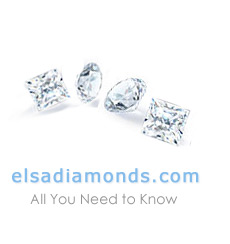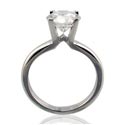
Diamonds
Basic Information about Diamonds
Diamonds have an allure about them that make them probably the most sought after gemstones in the world. They say that "diamonds are a girl's best friend", and more than likely that sentiment is due to their brilliance, their sparkle, and the way they make a person feel when wearing one.
But, what we know as these perfectly clear and beautiful gemstones start their lives as basically rocks.
Rough diamonds have to be mined and honed and crafted into what we know of as diamonds.
A diamond is a form of carbon, and its extreme hardness and light diffusion qualities make it a highly useful stone for industrial purposes, in addition to its pleasing aesthetic qualities. Diamonds make excellent abrasives because they can only be scratched by other diamonds. Therefore, they are extremely durable and retain their brilliant gleam wonderfully.
The earliest known reference to the diamond comes from a Sanskrit text dating back to approximately 296 BCE (before the Christian Era), which described the diamond's qualities. It is generally accepted that diamonds were first mined in India, where they quickly became symbols of spirituality and holiness, decorating religious idols. Early on in their history, diamonds were traded in all direction of India for their different industrial uses, including engraving and drilling, as well as for their aesthetic purposes such as for ceremony, decoration, and adornment. There was a strict prohibition against cutting diamonds. This taboo was started with the early traditional uses in India, and ended in the Middle Ages. By 1375, a guild of diamond cutters and polishers was established, as the technology of reshaping diamonds began to develop. The different shapes that were developed through the years only worked to exemplify the diamond's beauty and brilliance, increasing their allure. Today, diamonds are most familiarly used for the purposes of adornments, such as for jewelry.
earliest known reference to the diamond comes from a Sanskrit text dating back to approximately 296 BCE (before the Christian Era), which described the diamond's qualities. It is generally accepted that diamonds were first mined in India, where they quickly became symbols of spirituality and holiness, decorating religious idols. Early on in their history, diamonds were traded in all direction of India for their different industrial uses, including engraving and drilling, as well as for their aesthetic purposes such as for ceremony, decoration, and adornment. There was a strict prohibition against cutting diamonds. This taboo was started with the early traditional uses in India, and ended in the Middle Ages. By 1375, a guild of diamond cutters and polishers was established, as the technology of reshaping diamonds began to develop. The different shapes that were developed through the years only worked to exemplify the diamond's beauty and brilliance, increasing their allure. Today, diamonds are most familiarly used for the purposes of adornments, such as for jewelry.
There are 4 characteristics that are used as basic description devices of diamonds, and which are used in order to determine the ultimate value of a particular diamond. These are known as the "4 C's", or carat, clarity, color, and cut. The carat is the weight that measures the mass of the diamond. One carat equals approximately 0.007 ounce. The value of a diamond increases greatly relative to its carat weight, because large diamonds are exceptional and in high demand for jewelry.
The clarity of a diamond measures the amount of inclusions of a diamond, or its internal flaws. Foreign matter inside the diamond or cracks causing a cloudy appearance are considered inclusions, and tend to decrease the value of a diamond. There grading systems used to assess clarity, based on certain factors including number, size, color, and visibility of the inclusions (diamonds are usually graded from flawless to imperfect). The higher the clarity rating is, the more rare the diamond (and the more valuable) is.
The color of a structurally perfect diamond, and one that is free of chemicals is almost perfectly clear, and color-free to the naked eye. This doesn't necessarily affect the value of a diamond, however. Some pink or blue colored diamonds (like the Hope Diamond, for example) are considered spectacular, and therefore highly valuable. A rating system of D to Z (D=colorless and Z=bright yellow) is in use to aid in color assessment of diamonds.
The cut of a diamond describes how the diamond has been shaped and polished from its original mined state. The "cut" describes the level of workmanship that has gone into the diamond, as well as the angles to which the diamond is cut. This is not the same as the shape of the diamond, which describes just that, its shape. Shapes such as pear, round, marquis, princess are all familiar terms for diamond jewelry. When shopping for diamond jewelry, fine jewelry stores will be aware of the 4 C's of the diamond they carry, and will be able to provide information about which gems you are interested in. Diamonds are unique, and they are the ultimate souvenirs from the Earth, which adds even more allure to owning one.


